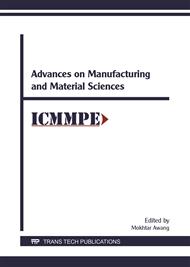p.48
p.54
p.60
p.65
p.70
p.75
p.81
p.86
p.93
The Effect of Surface Treatment on 0.16% Chromium and 1.32% Nickel Alloyed Ductile Iron (Di) through Boronizing Process
Abstract:
This paper aim to investigate the effect on microstructure, hardness and wear (slurry erosion) of alloyed ductile iron (DI) with addition of 0.16% Chromium and 1.32% Nickel before and after boronizing process. The specimens were prepared by melting the Ductile Iron compositions through CO2 sand casting method. Specimens were fully coated with boronizing paste and heated at 850°C and 900°C for 8 hours holding time. Microstructures of the specimens were observed under Olympus BX 41M Optical Microscope. Vickers Micro Hardness Tester was used to determine the hardness of the specimens while Wear Test (Slurry Erosion) to measure the wear volume of each specimen. After boronizing process, the boron element diffused into the specimens which make the surface harden. The thickest boride layer was detected at sample with temperature 900°C. The samples of 900°C give higher hardness than temperature 850°C which is 2909 HV and 1395 HV respectively. Referring to surface roughness test, samples boronized at 900oC had high wear resistance compared to sample boronized at 850oC and as cast. The selection temperature in boronizing treatment can prevent the rate of wear thus can identify the hardness of surface in order to prolong the equipment and application or even structure.
Info:
Periodical:
Pages:
70-74
Citation:
Online since:
June 2017
Keywords:
Price:
Сopyright:
© 2017 Trans Tech Publications Ltd. All Rights Reserved
Share:
Citation:


